Clams (Bivalvia) are a class of aquatic molluscs that live attached to rocks or other objects, feeding on plankton that the water sucks in. The body of mussels is composed of head, torso and leg and is protected by one or two symmetrical shells. Shells are covered with highly flexible ligament, through which one or two muscles on the inside open or closing them.
The hard shells are made primarily of calcium carbonate. There are thousands of species of mussels, spread throughout all the seas and oceans of the world, some of which are freshwater.
The most productive layer depth for them is between 3 and 10 meters, the black shell consists of three layers and contains 90% calcium carbonate. The color is black or dark gray. The inner surface is covered with nacreous layer.
Mussels are called filter of the sea - they suck not only good ingredients, but also bad. At 17 ° C temperature of the sea water, the old black mussel filters up to 3 liters in 1 hour or 82 liters of water a day, keeps phytoplankton detrid and unicellular organisms. At 0°C mussel is dormant, not growing and eating.
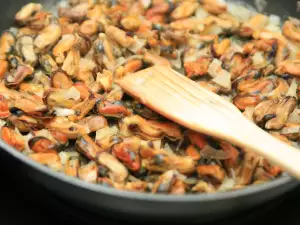
The most intense periods of growth and feeding occurs in spring and autumn. Black leather is the most commonly consumed type worldwide. Mussels grown in mussel farms are different from those coming from the Mediterranean and Spain, which are wider and rounder. No less popular than black mussels are common scallops. They are much larger and more fleshy and are available from late September to May.
Frozen and shelled, they can be found throughout the year. Their size reaches 10-15 cm, and a shell with the meat is around a solid 90 g. The name of the mussels come from the Middle Ages, when pilgrims of Saint Jacques de Compostela along the beach collecting shells and put them on their clothes as a sign that visited the holy place.
Scallops inhabit depths from 5 to 40 m of the sandy bottom of the Atlantic coast of France and Spain. Later, their exceptional taste becomes a real discovery for fishermen, until we reach the day when scallops are loved in French cuisine, and not only.
Composition of mussels
Protein levels In mussel and beef are almost identical, with the difference that mussels contain 11 times more calcium and two times more phosphorus, 4 times less calories and up to 11 times less fat. The meat of the mussels constitutes 20 to 32% of their mass. Chemical composition of the meat is water - 85%, fat - 1, 5%, protein - 8%, carbohydrate – 2- 3% of which 0, 5% is glycogen.
Mussels have impressive levels of vitamins of group B (B1, B2, B12) and C, are rich in phosphorus, calcium, iron, copper, manganese, iodine, cobalt and arsenic. Mussels are far cheaper than oysters, but on top of that are a more nutritious food. They contain more Omega-3 fatty acids than any other shellfish is. 100 g mussels contains about 137 calories.
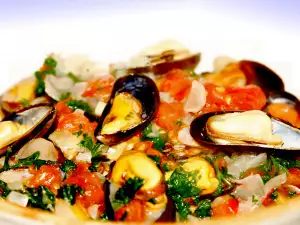
Selection and storage of mussels
Fresh black mussels are bright and tightly closed. When buying mussels, make sure they are really fresh and basically alive. Shellfish sea creatures must be closed without broken sections. If they are open - they are not fresh and pose health risks.
Sign that the mussels were fresh, is the crisp pleasant scent of the sea. If they have a rather heavy odor do not buy them. If there is a small gap between the two shells, tap the shell with your finger - if it is closed, then it is fresh. Do not use edible mussels that remain open after this test.
In recent decades in Europe (and worldwide) more mussel farms emerge. Because of the increasing pollution of the oceans and seas, it is better to buy mussels from farms, not from casual fishermen. Marine clams often contain very harmful and heavy particles.
Uncleaned mussels can keep stuffed in a large plastic bag. They should be able to open, because that way you will lose fluid. It is best to cook just bought mussels same day but in wet towels or newspapers in the lower compartment of the refrigerator, you can keep them for 3-4 days. Mussels need to breathe.
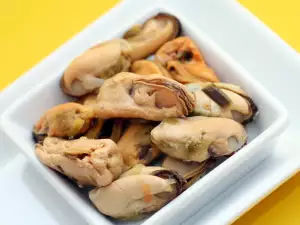
Cooking Mussels
Before cooking mussels, rinse and soak them for 20 minutes in cold water - this way they will throw out their sand, salt and other inhibitors. Once the mussels are cleaned with a brush under running water, remove everything from their shells. Another way is to clean the shells and scrape them between your palms with sea salt and rinse under water.
Next step is to pull the beard off the mussels by pulling sharply. Then the mussels are ready for culinary use. Cook the mussels in a large pot. Once opened, their volume increases threefold, and the open shell is ready to be removed.
Typically, 500 g of mussels in the shell are sufficient for a one meal serving. A popular way to prepare mussels is smothering them with butter, white wine, onions, garlic and spices. Mussels combine very well with lovage, garlic, onion, pepper and others.
There are countless ways to prepare them – stuffed, steamed and then incorporated into a variety of dishes, steamed, or roasted. Shelled mussels are one of the main ingredients of the famous Paella, but also used with various salads, stews with seafood, combining well with rice and others, like Italian pasta, etc.
Soup of mussels is a real delight for the palate and mussels are a romantic reminder of the past in its native coast.
They are often served in American style - white oil or Provence style- steamed or skewers. Considered to be a unique and exquisite part of French cuisine.
Especially tasty, they are considered a delicacy, with a very fine taste, which does not tolerate long culinary use. Often mussels are needing to be cooked for just a second. They can be consumed raw - marinated in olive oil with lemon or as an ingredient in salads.
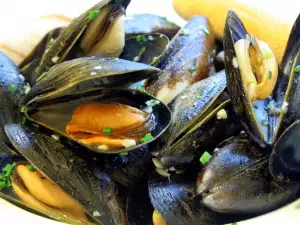
French Recipe for Mussels
Ingredients: mussels - 2 kg fresh and clean, parsley - 4 tablespoons chopped, fresh salt - 1 teaspoon, white wine - 230 ml dry, garlic - 3 cloves, sliced onions - shallots 1 head, finely crushed butter - 120 g
Preparation: In a large skillet, heat half the oil and fry the onion and garlic for 2 minutes. If mussels do not close when you press or have broken shells, remove them. Pour remaining mussels to the pan with the wine and season with salt and pepper.
Cover and sauté for about 3 minutes, periodically rocking the dish. Remove the mussels solutions and put them in separate deep dish. In the rest of the sauce in the pan add the remaining butter and parsley. Wait for the oil to "shine" and toss scallops with him. Serve mussels with French circled fresh baguette.
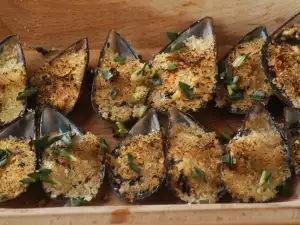
Benefits of mussels
Mussels are a valuable and healthy seafood, which should not be denying ourselves, if we know their quality. Phosphorus shells helps our body to maintain acid balance and regulate energy metabolism of cells. Phosphorous is good for the nervous system, brain, bones and teeth as well as the entire physiological process. Mussels are a "food of happiness" and chase depression.
These seafoods are rich in zinc, which helps our sunburned skin does not dehydrate. Iodine in mussels is important for the thyroid gland. It is known that seafood is several times lower in calories than meat of mammals, which we mostly eat. This makes mussels diet food, appropriate with diets for weight reduction.
Chinese traditional medicine recommends clams against hair loss. It is a known fact that mussels are an aphrodisiac and cause sexual appetite.
Dangers of clams
Poisoning with inedible shells or just poorly made clams, are not at all rare. In addition, mussels are not recommended for people with sea food allergies.
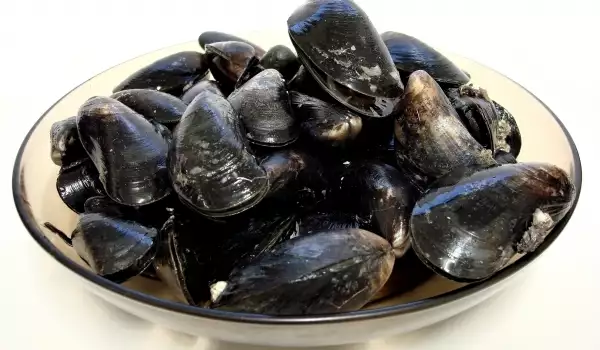

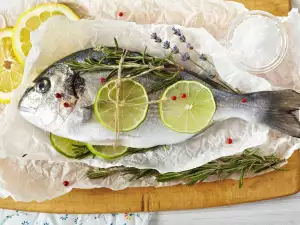

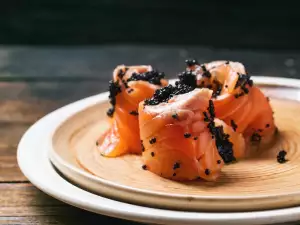
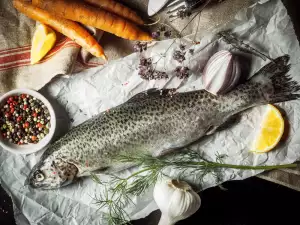
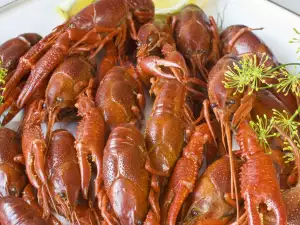
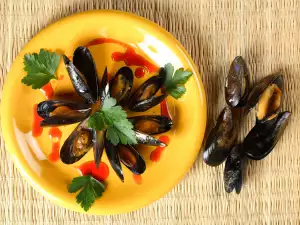
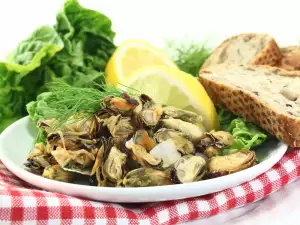
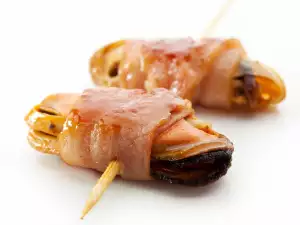
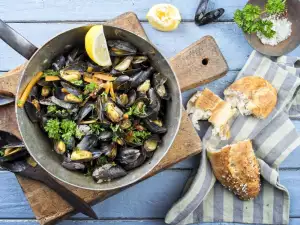
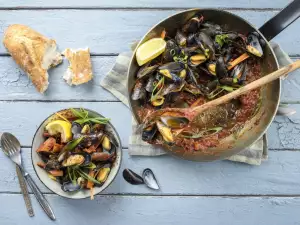
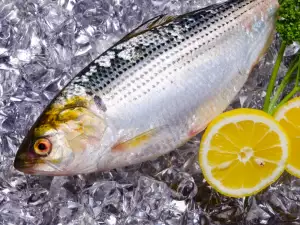
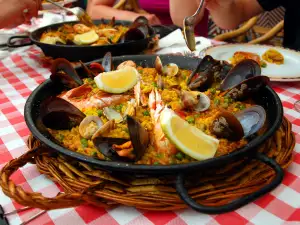




Comments